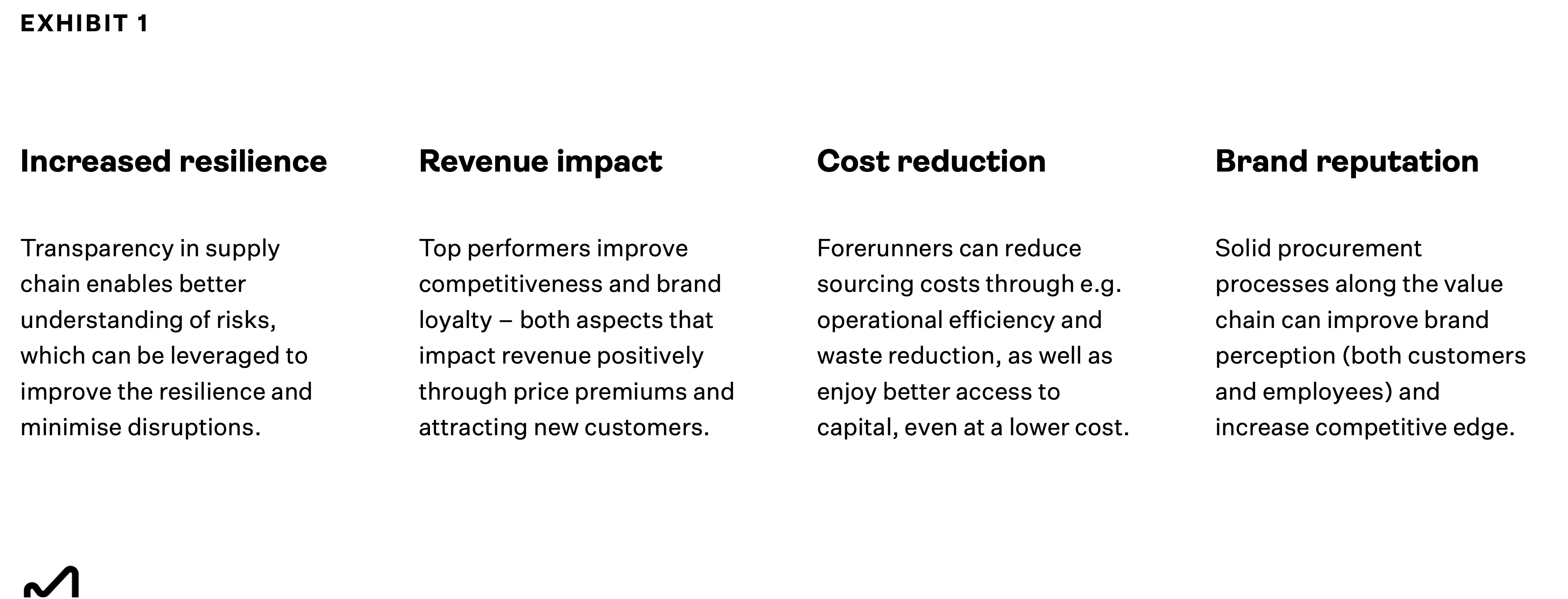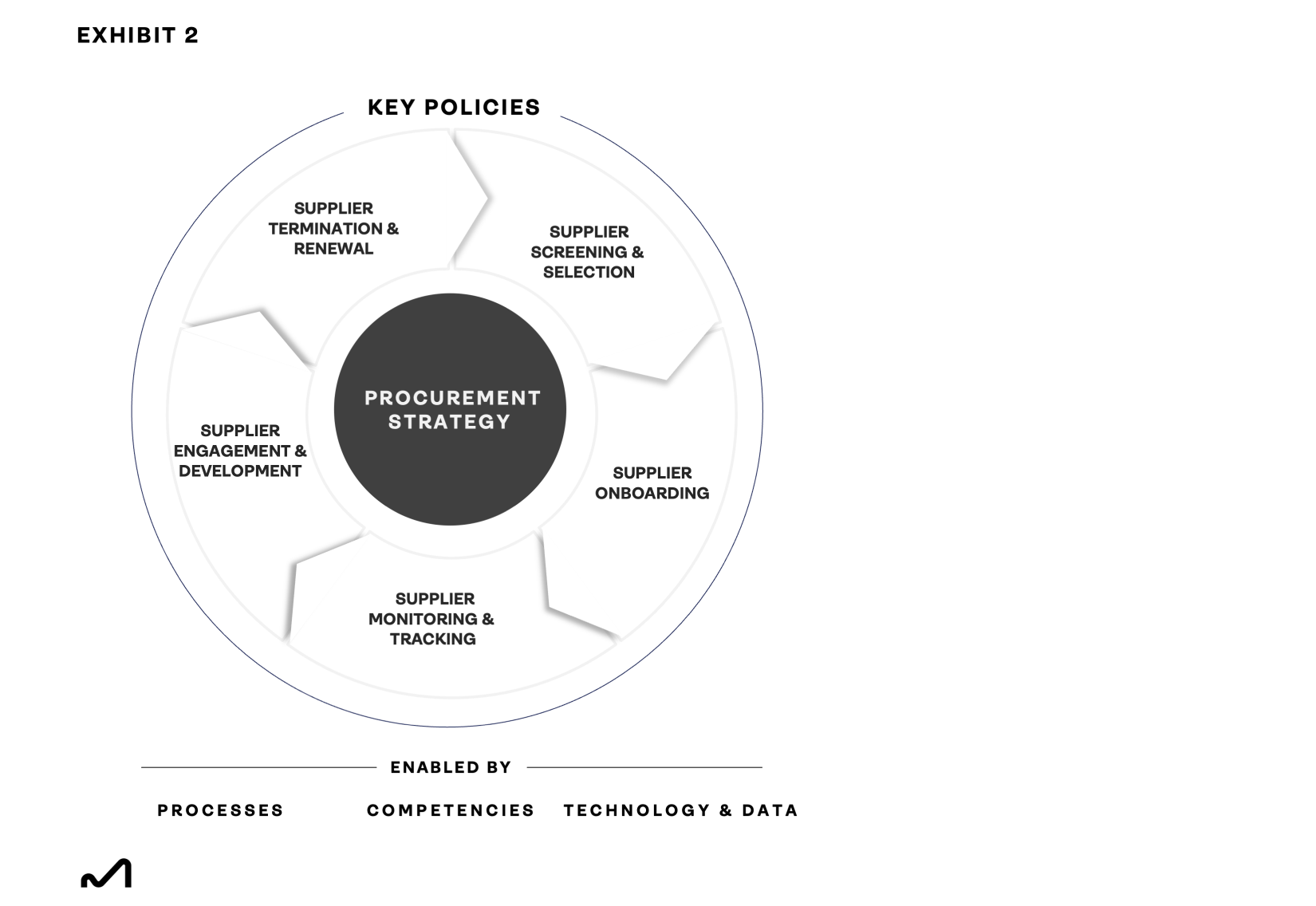13 March 2024
Achieving excellence in sustainable procurement
Max Knuts
Head of Strategy Practice
13 March 2024
Achieving excellence in sustainable procurement
Max Knuts
Head of Strategy Practice
As businesses strive to remain competitive while meeting regulatory requirements and societal expectations, sustainable procurement has emerged as a pivotal avenue for achieving excellence. This blog post delves into the essential elements that distinguish leading sustainable procurement practices, highlighting how sustainability should integrated seamlessly into procurement processes within your organisation.
At the core of sustainable procurement lies a multitude of business benefits. Beyond meeting regulatory requirements and societal expectations, sustainable procurement transformations have the potential to yield significant commercial impact through dimensions presented in Exhibit 1. At their best, these initiatives go beyond mere compliance, driving improved supply chain resilience and revenue growth while also reducing the exposure to risks and enabling cost-savings and brand recognition.
Benefits of sustainable procurement

To stand out as a leader in sustainable procurement and to reap the full benefits, companies need to integrate sustainability into their procurement strategy, and supporting policies, across each step in the procurement process as presented in Exhibit 2. In practice this means incorporating the sustainability lens to transforming procurement operations instead of focusing only on cutting costs. Let’s next turn towards what sustainable procurement practices look like in each of the key steps.
Procurement process steps into which sustainability should be integrated

What does excellence look like in each step of the procurement process?
Step 0: Aligning Strategy with Sustainability Goals
At the heart of standout sustainable procurement lies the integration of sustainability into procurement strategy. This begins with setting ambitious, clear, and measurable targets. These targets should not only define what, how, and from whom to buy but also receive a mandate from executive management. Transparency in targets is key, with companies publicly disclosing target levels and achievements while supplementing quantitative goals with qualitative measures. Targets also support establishing clear boundaries in terms of products, services, or industries that are incompatible with the company’s sustainability objectives. To achieve these targets, a well-defined roadmap that outlines a clear trajectory is needed.
Step 1: Rigorous Supplier Screening and Selection
The foundation of sustainable procurement rests on selecting suppliers that align with sustainability goals. Clear selection criteria prioritize suppliers' sustainability performance, with top management mandating the procurement of sustainable goods and services. Pre-sourcing supplier screening goes beyond surface-level assessments, delving into geographical, industry, raw material, and business model-related risks. High-risk suppliers undergo thorough evaluations, including impact assessments and pre-partnership audits. Furthermore, a commitment to supplier diversity ensures the inclusion and support of minority-owned and led businesses within supply chains.
Step 2: Comprehensive Supplier Onboarding
Effective onboarding processes are crucial for integrating sustainability into supplier relationships. Leading companies allocate sufficient resources for onboarding, with tailored approaches for high-volume or high-risk suppliers. Clear guidelines regarding Supplier Code of Conduct content ensure suppliers know what is required and how they can fulfill these criteria all the way to Tier 2 and Tier 3 suppliers. In addition to clear guidelines, training workshops and accessible supplier portals support suppliers in ensuring all practices are aligned with sustainable procurement practices.
Step 3: Ongoing Supplier Monitoring and Tracking
Sustainable procurement extends beyond initial selection, requiring ongoing monitoring and tracking of supplier performance. Leaders in sustainable procurement take a risk-based approach to categorizing suppliers based on identified risk categories such as sourcing volume, geography, industry, business model, raw material. Tools such as self-assessments, regular dialogue, and audits enable companies to mitigate risks effectively. Stakeholder engagement ensures transparency and accountability while also fostering dialogue with impacted parties. Grievance mechanisms aligned with international standards and clear commitment and approach to remedy ensure impacted parties are compensated rightfully.
Step 4: Supplier Engagement and Development
Supplier engagement goes beyond transactional relationships, focusing on mutual development and collaboration. Corrective action plans address challenges identified through monitoring, while development programs enhance suppliers' sustainability capabilities. Communication efforts promote transparency throughout the supply chain, ensuring that e.g., workers in the supply chain are aware of what is being done to mitigate potential adverse impacts. Collaboration within the industry and strategic partnerships with NGOs drive collective progress, while specific programmes can support e.g. minority-owned/led suppliers to enhance their competitive advantages and access to wider market or facilitate supply chain innovations.
Step 5: Strategic Supplier Termination or Renewal
Companies should have clear processes and structure approaches for supplier termination to mitigate legal risks and uphold professional relationships. In practice this means for example clear thresholds for when Supplier Code of Conduct violations and failer corrective action plans pose a reason for termination. Of equal importance is that the implications of terminating the supplier relationship, from for example human rights perspective, are assessed and that there exist clear transition plans for terminated suppliers.
Leaders in sustainable procurement practices also regularly review suppliers when relationships are renewed, or when major changes happen in the business model or supply chain. Regular review of supplier practices is also important from the perspective of ensuring that suppliers comply with changing sustainable procurement practices, targets, and policies.
Excellence in procurement means integrating sustainability at every step — from supplier selection to strategic partnership renewal.
In summary, sustainable procurement isn't just a box to tick—it's a golden opportunity to level up your business. By prioritizing supply chain transparency, integrating sustainability into your DNA, and forging strong supplier partnerships, you'll not only stand out in the crowd as a leader in sustainable procurement but also drive positive commercial impacts.
Let's talk about how to make this happen
We help you set the foundation and grow into becoming true business leaders in vast sustainability transformations.
Mia Folkesson
Managing Partner
mia@impaktly.com
Let's talk about how to make this happen
We help you set the foundation and grow into becoming true business leaders in vast sustainability transformations.
Mia Folkesson
Managing Partner
mia@impaktly.com